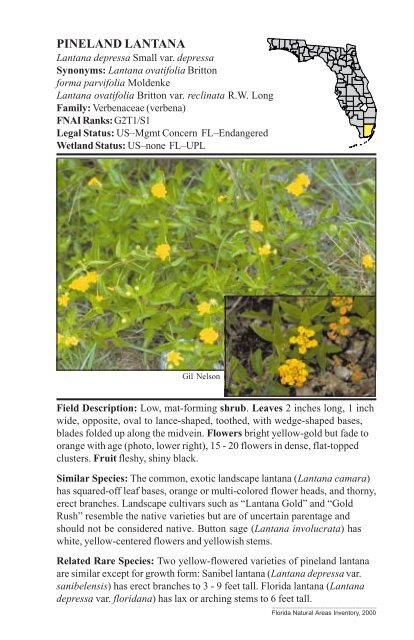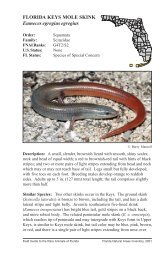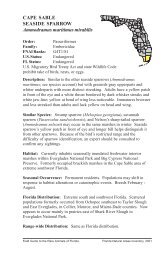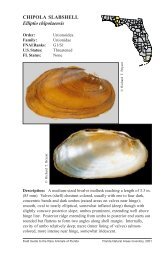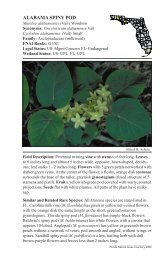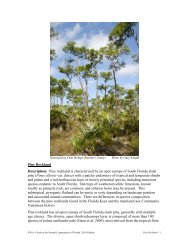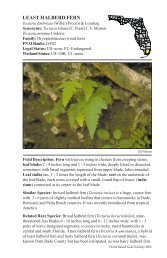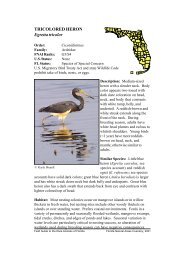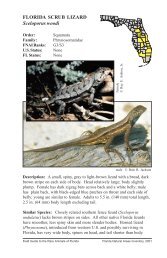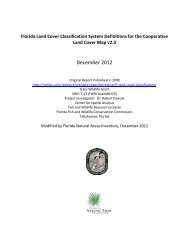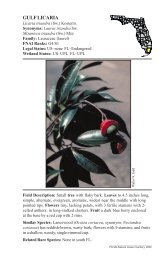Lantana depressa var. floridana - Florida Natural Areas Inventory
Lantana depressa var. floridana - Florida Natural Areas Inventory
Lantana depressa var. floridana - Florida Natural Areas Inventory
You also want an ePaper? Increase the reach of your titles
YUMPU automatically turns print PDFs into web optimized ePapers that Google loves.
PINELAND LANTANA<br />
<strong>Lantana</strong> <strong>depressa</strong> Small <strong>var</strong>. <strong>depressa</strong><br />
Synonyms: <strong>Lantana</strong> ovatifolia Britton<br />
forma parvifolia Moldenke<br />
<strong>Lantana</strong> ovatifolia Britton <strong>var</strong>. reclinata R.W. Long<br />
Family: Verbenaceae (verbena)<br />
FNAI Ranks: G2T1/S1<br />
Legal Status: US–Mgmt Concern FL–Endangered<br />
Wetland Status: US–none FL–UPL<br />
Gil Nelson<br />
Field Description: Low, mat-forming shrub. Leaves 2 inches long, 1 inch<br />
wide, opposite, oval to lance-shaped, toothed, with wedge-shaped bases,<br />
blades folded up along the midvein. Flowers bright yellow-gold but fade to<br />
orange with age (photo, lower right), 15 - 20 flowers in dense, flat-topped<br />
clusters. Fruit fleshy, shiny black.<br />
Similar Species: The common, exotic landscape lantana (<strong>Lantana</strong> camara)<br />
has squared-off leaf bases, orange or multi-colored flower heads, and thorny,<br />
erect branches. Landscape culti<strong>var</strong>s such as “<strong>Lantana</strong> Gold” and “Gold<br />
Rush” resemble the native <strong>var</strong>ieties but are of uncertain parentage and<br />
should not be considered native. Button sage (<strong>Lantana</strong> involucrata) has<br />
white, yellow-centered flowers and yellowish stems.<br />
Related Rare Species: Two yellow-flowered <strong>var</strong>ieties of pineland lantana<br />
are similar except for growth form: Sanibel lantana (<strong>Lantana</strong> <strong>depressa</strong> <strong>var</strong>.<br />
sanibelensis) has erect branches to 3 - 9 feet tall. <strong>Florida</strong> lantana (<strong>Lantana</strong><br />
<strong>depressa</strong> <strong>var</strong>. <strong>floridana</strong>) has lax or arching stems to 6 feet tall.<br />
______________________________<br />
<strong>Florida</strong> <strong>Natural</strong> <strong>Areas</strong> <strong>Inventory</strong>, 2000
Pineland lantana <strong>Lantana</strong> <strong>depressa</strong> <strong>var</strong>. <strong>depressa</strong><br />
Habitat: Pineland lantana: pine rocklands of southern Dade County,<br />
especially Everglades keys. Sanibel lantana: dunes, coastal grasslands, and<br />
sandy inland ridges. <strong>Florida</strong> lantana: dunes and sandy inland ridges.<br />
Best Survey Season: Flowers all year.<br />
Range-wide Distribution: Pineland lantana: endemic to Dade County, FL.<br />
Sanibel lantana: endemic to SW coast of FL. <strong>Florida</strong> lantana: endemic to SE<br />
coast of FL.<br />
Conservation Status: Although found on many conservation areas, all 3<br />
<strong>var</strong>ieties are threatened by exotic species invasion and by “genetic swamping”<br />
through hybridization with <strong>Lantana</strong> camara.<br />
Protection & Management: Where native <strong>var</strong>ieties occur with <strong>Lantana</strong><br />
camara, removal of this exotic species is urgent. Burn pine rocklands every<br />
2 - 3 years. Protect coastal habitats from development.<br />
References: Coile 2000, Hammer 1997, IRC 1999, Nelson 1996, Sanders 1987,<br />
Wunderlin 1998, Wunderlin and Hansen 2000a.<br />
______________________________<br />
<strong>Florida</strong> <strong>Natural</strong> <strong>Areas</strong> <strong>Inventory</strong>, 2000<br />
wedge-shaped<br />
leaf base<br />
<strong>Lantana</strong> camara<br />
squared-off<br />
leaf base


